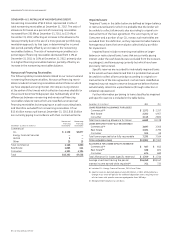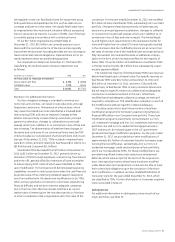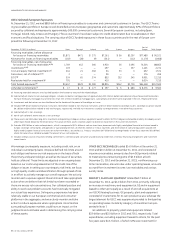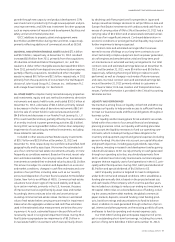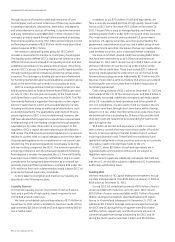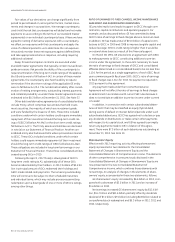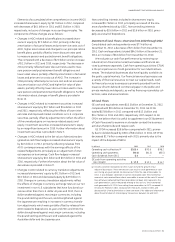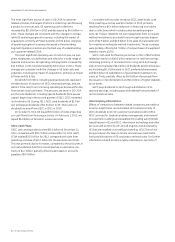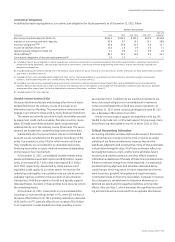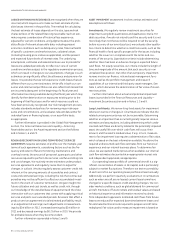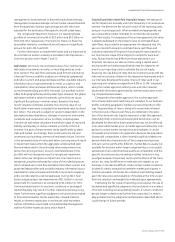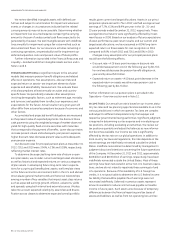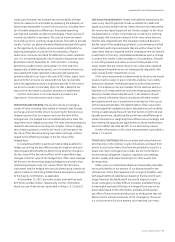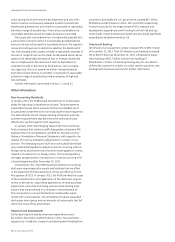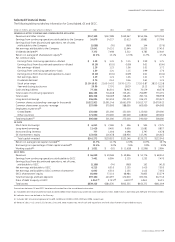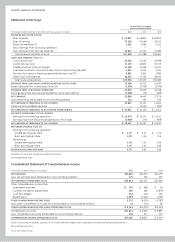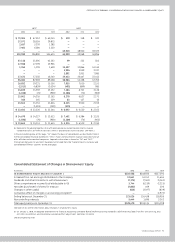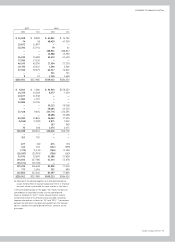GE 2012 Annual Report Download - page 66
Download and view the complete annual report
Please find page 66 of the 2012 GE annual report below. You can navigate through the pages in the report by either clicking on the pages listed below, or by using the keyword search tool below to find specific information within the annual report.management’s discussion and analsis
64 GE 2012 ANNUAL REPORT
LOSSES ON FINANCING RECEIVABLES are recognized when they are
incurred, which requires us to make our best estimate of prob-
able losses inherent in the portfolio. The method for calculating
the best estimate of losses depends on the size, type and risk
characteristics of the related financing receivable. Such an esti-
mate requires consideration of historical loss experience,
adjusted for current conditions, and judgments about the prob-
able effects of relevant observable data, including present
economic conditions such as delinquency rates, financial health
of specific customers and market sectors, collateral values
(including housing price indices as applicable), and the present
and expected future levels of interest rates. The underlying
assumptions, estimates and assessments we use to provide for
losses are updated periodically to reflect our view of current
conditions and are subject to the regulatory examination process,
which can result in changes to our assumptions. Changes in such
estimates can significantly affect the allowance and provision for
losses. It is possible that we will experience credit losses that are
different from our current estimates. Write-offs in both our con-
sumer and commercial portfolios can also reflect both losses that
are incurred subsequent to the beginning of a fiscal year and
information becoming available during that fiscal year which may
identify further deterioration on exposures existing prior to the
beginning of that fiscal year, and for which reserves could not
have been previously recognized. Our risk management process
includes standards and policies for reviewing major risk expo-
sures and concentrations, and evaluates relevant data either for
individual loans or financing leases, or on a portfolio basis,
as appropriate.
Further information is provided in the Global Risk Management
section, the Financial Resources and Liquidity—Financing
Receivables section, the Asset Impairment section that follows
and in Notes 1, 6 and 23.
REVENUE RECOGNITION ON LONG-TERM PRODUCT SERVICES
AGREEMENTS
requires estimates of profits over the multiple-year
terms of such agreements, considering factors such as the fre-
quency and extent of future monitoring, maintenance and
overhaul events; the amount of personnel, spare parts and other
resources required to perform the services; and future billing rate
and cost changes. We routinely review estimates under product
services agreements and regularly revise them to adjust for
changes in outlook. We also regularly assess customer credit risk
inherent in the carrying amounts of receivables and contract
costs and estimated earnings, including the risk that contractual
penalties may not be sufficient to offset our accumulated invest-
ment in the event of customer termination. We gain insight into
future utilization and cost trends, as well as credit risk, through
our knowledge of the installed base of equipment and the close
interaction with our customers that comes with supplying critical
services and parts over extended periods. Revisions that affect a
product services agreement’s total estimated profitability result
in an adjustment of earnings; such adjustments increased earn-
ings by $0.4 billion in 2012, increased earnings by $0.4 billion in
2011 and decreased earnings by $0.2 billion in 2010. We provide
for probable losses when they become evident.
Further information is provided in Notes 1 and 9.
ASSET IMPAIRMENT assessment involves various estimates and
assumptions as follows:
Investments. We regularly review investment securities for
impairment using both quantitative and qualitative criteria. For
debt securities, if we do not intend to sell the security and it is not
more likely than not that we will be required to sell the security
before recovery of our amortized cost, we evaluate other qualita-
tive criteria to determine whether a credit loss exists, such as the
financial health of and specific prospects for the issuer, including
whether the issuer is in compliance with the terms and cov-
enants of the security. Quantitative criteria include determining
whether there has been an adverse change in expected future
cash flows. For equity securities, our criteria include the length of
time and magnitude of the amount that each security is in an
unrealized loss position. Our other-than-temporary impairment
reviews involve our finance, risk and asset management func-
tions as well as the portfolio management and research
capabilities of our internal and third-party asset managers. See
Note 1, which discusses the determination of fair value of invest-
ment securities.
Further information about actual and potential impairment
losses is provided in the Financial Resources and Liquidity—
Investment Securities section and in Notes 1, 3 and 9.
Long-Lived Assets. We review long-lived assets for impairment
whenever events or changes in circumstances indicate that the
related carrying amounts may not be recoverable. Determining
whether an impairment has occurred typically requires various
estimates and assumptions, including determining which undis-
counted cash flows are directly related to the potentially impaired
asset, the useful life over which cash flows will occur, their
amount, and the asset’s residual value, if any. In turn, measure-
ment of an impairment loss requires a determination of fair value,
which is based on the best information available. We derive the
required undiscounted cash flow estimates from our historical
experience and our internal business plans. To determine fair
value, we use quoted market prices when available, our internal
cash flow estimates discounted at an appropriate interest rate
and independent appraisals, as appropriate.
Our operating lease portfolio of commercial aircraft is a sig-
nificant concentration of assets in GE Capital, and is particularly
subject to market fluctuations. Therefore, we test recoverability
of each aircraft in our operating lease portfolio at least annually.
Additionally, we perform quarterly evaluations in circumstances
such as when aircraft are re-leased, current lease terms have
changed or a specific lessee’s credit standing changes. We con-
sider market conditions, such as global demand for commercial
aircraft. Estimates of future rentals and residual values are based
on historical experience and information received routinely
from independent appraisers. Estimated cash flows from future
leases are reduced for expected downtime between leases and
for estimated technical costs required to prepare aircraft to be
redeployed. Fair value used to measure impairment is based on


